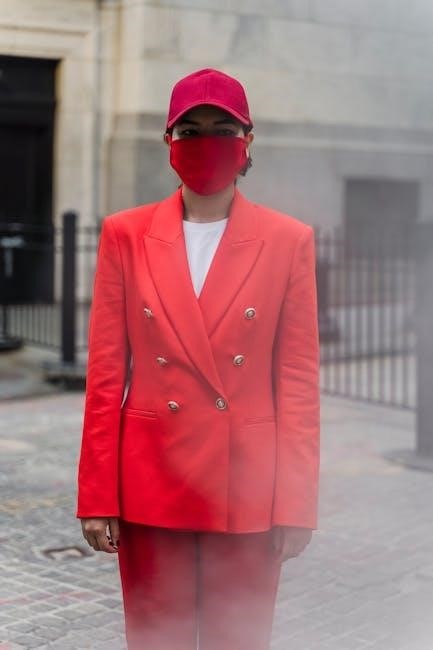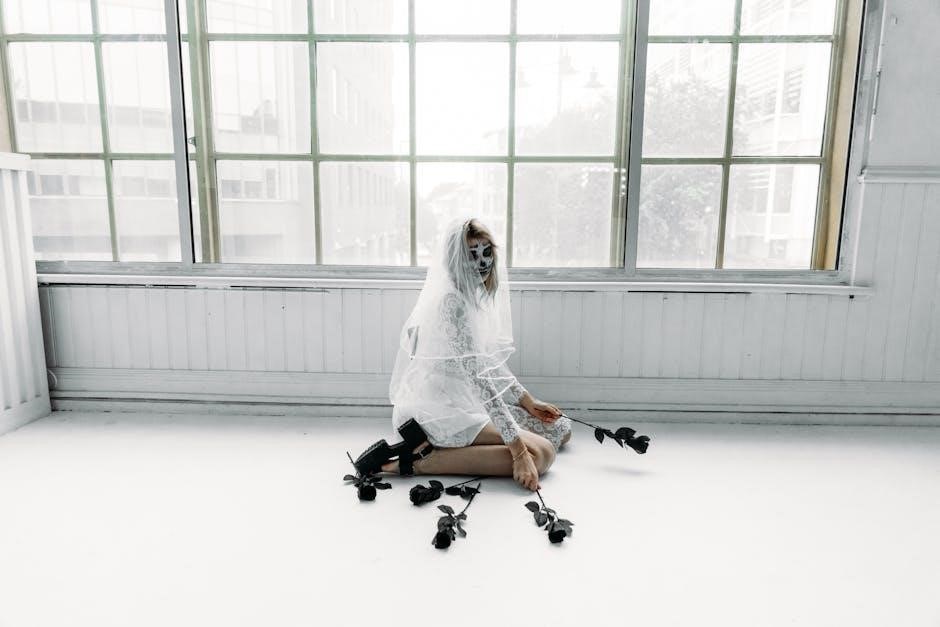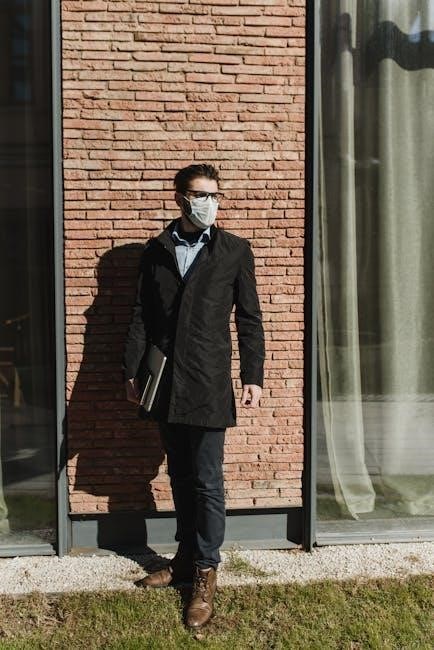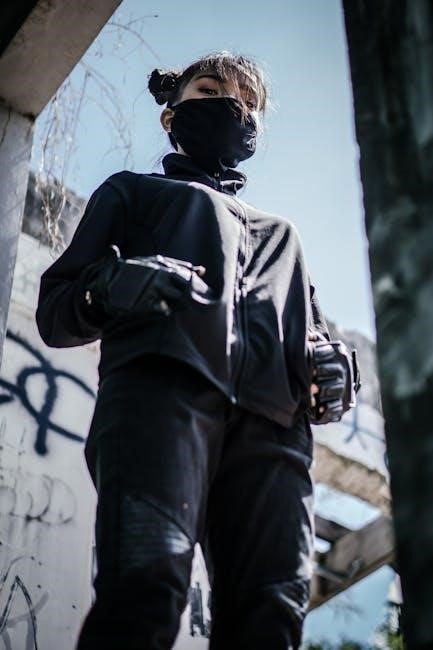Paul Laurence Dunbar’s We Wear the Mask explores themes of societal expectations and racial disparities, offering a poignant look at hidden emotions behind a facade.
Overview of the Poem
We Wear the Mask by Paul Laurence Dunbar is a powerful exploration of societal expectations and racial disparities. The poem delves into the dual identities people adopt to navigate oppressive environments, using the metaphor of a mask to symbolize concealment of true emotions. Through vivid imagery and wordplay, Dunbar highlights the tension between outward appearances and inner realities. The rondeau form adds a musical quality, reinforcing the poem’s emotional depth. Originally published in 1896, it remains a landmark work in African American literature, offering insights into the struggles of identity and resilience. The poem’s central theme of hiding pain behind a facade resonates universally, making it a timeless commentary on societal pressures and human endurance.
Historical Context of the Poem
We Wear the Mask was written by Paul Laurence Dunbar in 1896, a period marked by racial tension and the rise of Jim Crow laws in the United States. The poem reflects the struggles of African Americans in the post-Civil War era, where societal expectations forced them to conceal their true emotions and identities. Dunbar, an African American poet, captured the duality of life for Black individuals, who often wore a “mask” of compliance and happiness to navigate a world fraught with racism and oppression. The poem resonates with the broader context of racial disparities and the resilience of marginalized communities. Its themes of concealment and dual identity remain relevant, offering a powerful commentary on the human experience during one of America’s most tumultuous periods.
Themes and Central Ideas
The poem We Wear the Mask delves into profound themes of dual identity, societal concealment, and racial disparity. It explores how individuals, particularly African Americans, hide their true emotions behind a “mask” to meet societal expectations. The central idea revolves around the tension between the outward appearance of compliance and the inner reality of suffering. Dunbar highlights the emotional toll of this duality, where people smile and pretend despite their pain. The poem also critiques the oppressive systems that force such concealment, emphasizing the resilience of those who endure while longing for authenticity. These themes resonate universally, making the poem a powerful commentary on identity, race, and the human condition. The mask serves as a metaphor for the façade people adopt to survive in an unforgiving world.
The poem explores the mask worn to hide true emotions and identities, reflecting societal pressures and racial disparities, with a focus on internal pain versus external appearances.
Stanza-by-Stanza Breakdown
The poem We Wear the Mask by Paul Laurence Dunbar is divided into four stanzas, each exploring the theme of concealment and societal pressure. In the first stanza, Dunbar introduces the metaphor of the mask, describing how it hides the wearer’s true emotions. The lines “It hides our cheeks and shades our eyes” emphasize the physical and emotional concealment. The second stanza delves into the pain behind the mask, with phrases like “torn and bleeding hearts” and “mouth with myriad subtleties,” highlighting the struggle to maintain a facade. The third stanza, referencing biblical imagery, suggests a moral conflict, while the final stanza conveys resignation, acknowledging the necessity of the mask. Together, the stanzas create a powerful narrative of duality and oppression.
Key Imagery and Symbolism
In We Wear the Mask, Paul Laurence Dunbar employs vivid imagery and symbolism to convey the themes of concealment and societal oppression. The mask serves as the central symbol, representing the facade worn by African Americans to hide their true emotions and endure racial discrimination. Imagery such as “torn and bleeding hearts” and “mouth with myriad subtleties” illustrates the internal pain and the complexity of maintaining this disguise. The “clay is vile beneath our feet” symbolizes the harsh realities of oppression, while “singing” despite suffering reflects resilience. Biblical allusions, like “the debt we pay to human guile,” add moral depth, suggesting a world governed by deceit and hypocrisy. These elements collectively paint a poignant picture of duality and the struggle for authenticity in a hostile environment.

Speaker’s Tone and Emotions
The speaker’s tone in We Wear the Mask is predominantly one of bitterness and despair, reflecting the collective suffering of African Americans under racial oppression. The poem conveys a sense of resignation and frustration, as the speaker reveals the emotional toll of hiding true feelings behind a mask. The use of phrases like “torn and bleeding hearts” and “mouth with myriad subtleties” underscores the pain and complexity of maintaining this facade. There is also a subtle irony in the speaker’s voice, as they describe the act of “singing” while inwardly suffering. This duality of outward calm and inner turmoil highlights the emotional conflict and the oppressive reality faced by the speaker and their community. The tone ultimately evokes a sense of hopelessness and longing for authenticity in a world that demands concealment.

Analysis of Major Themes
Paul Laurence Dunbar’s We Wear the Mask delves into themes of dual identity, societal expectations, and racial disparity, exploring the tension between external conformity and inner truth.
The Concept of Dual Identity
Dunbar’s poem explores the dual identity of African Americans, forced to wear a mask of conformity to navigate a hostile society while concealing their true selves. The mask symbolizes the divide between outward compliance and inner suffering, reflecting the painful duality of living in a world that demands suppression of authentic emotions and cultural identity. This duality is a survival mechanism, allowing individuals to cope with systemic oppression while privately enduring the weight of racial injustice. The poem vividly portrays the tension between the public persona and the hidden self, emphasizing the psychological toll of this constant performance. Through this lens, Dunbar critiques the societal expectations that enforce such duality, highlighting the resilience and stifled humanity of those who wear the mask.
Societal Expectations and Concealment
The poem underscores how societal expectations compel individuals to conceal their true emotions and identities. The mask serves as a survival mechanism, allowing African Americans to navigate a world dominated by racial prejudice and oppression. By wearing the mask, they outwardly conform to societal norms while inwardly enduring suffering. Dunbar highlights the tension between the public persona and the hidden self, revealing the emotional toll of this duality. The act of masking is portrayed as a necessary but painful response to systemic discrimination, illustrating the cost of conformity. The poem critiques a society that demands such concealment, emphasizing the resilience of those who must hide their true selves to survive. This theme resonates deeply, offering a powerful commentary on the human condition and the enduring impact of societal pressures.
Racial Disparity and Oppression

In We Wear the Mask, Paul Laurence Dunbar confronts the profound racial disparities and oppressive realities faced by African Americans during the late 19th and early 20th centuries. The poem vividly captures the emotional toll of systemic racism, as individuals are forced to hide their true selves behind a mask of compliance. Dunbar’s imagery, such as “torn and bleeding hearts” and “feet” walking a “long mile,” reflects the pain of enduring racial injustice while maintaining a facade of acceptance. The poem underscores the societal pressure to conform to white expectations, even as it critiques the hypocrisy of a system that demands such pretense. Through this powerful metaphor, Dunbar sheds light on the resilience of those who endure oppression while masking their suffering, highlighting the enduring struggle for equality and justice. The poem remains a poignant commentary on racial disparity and its emotional impact.
Inner vs. Outer Reality
In We Wear the Mask, Paul Laurence Dunbar masterfully explores the contrast between inner and outer reality, revealing the tension between public appearance and private suffering. The poem’s central metaphor of the mask symbolizes the dissociation between the outward facade of contentment and the inner turmoil of oppression. While the speaker and others outwardly “grin and lie,” their true emotions—“torn and bleeding hearts”—remain hidden. This duality reflects the societal pressure to conform and suppress genuine feelings, creating a disconnect between the individual’s authentic self and the persona they present to the world. Dunbar’s vivid imagery and wordplay emphasize the emotional cost of this duality, highlighting the psychological burden of maintaining such a separation. The poem thus offers a profound critique of the societal expectations that force individuals to conceal their true selves.
Literary Devices in the Poem
Dunbar employs a metaphor (the mask), rondeau form, biblical allusions, and vivid imagery to convey the emotional depth and societal critique in We Wear the Mask.
Use of Metaphor (The Mask)
The mask serves as a powerful metaphor, symbolizing concealment and duality. It represents the facade worn to hide true emotions, highlighting societal pressures and internal conflicts. Through this metaphor, Dunbar critiques racial disparities and the need for African Americans to present a false exterior to navigate a hostile world. The mask also signifies resilience, as it allows individuals to endure suffering while maintaining outward composure; This metaphor is central to the poem’s exploration of identity and oppression, making it a compelling and enduring symbol of human struggle.
Imagery and Wordplay
Dunbar employs vivid imagery and wordplay to convey the duality of life experienced by African Americans. The poem’s opening lines, “We wear the mask that grins and lies,” use imagery to depict the tension between outward appearance and inner truth. The phrase “torn and bleeding hearts” creates a stark contrast, highlighting the emotional pain hidden beneath the mask. Wordplay, such as “myriad subtleties,” underscores the complexity of maintaining this facade. The image of “feet” and “mile” symbolizes the arduous journey of navigating societal expectations. These literary devices emphasize the struggle to reconcile inner reality with the external persona, making the poem a powerful exploration of identity and oppression.
Form and Meter (Rondeau)

We Wear the Mask is written in the form of a rondeau, a French poetic structure characterized by a specific repeating refrain and a consistent meter. The poem follows an ABABABBCDECDE rhyme scheme, with a refrain (“We wear the mask”) that recurs throughout, emphasizing the central theme of concealment. The meter is primarily iambic tetrameter, creating a rhythmic flow that mirrors the tension between the outward facade and the inner emotional pain. The structure reinforces the idea of a repetitive, forced performance, as the speaker and others don the mask to navigate societal expectations. The rondeau’s musicality contrasts with the poem’s somber tone, highlighting the disparity between appearance and reality. This form underscores Dunbar’s exploration of dual identity and the burdens of concealment.

Biblical Allusions
We Wear the Mask contains subtle biblical allusions that enrich its thematic depth. For instance, the reference to Christ in the third stanza evokes imagery of salvation and divine intervention, emphasizing the speaker’s longing for spiritual cleansing. The poem’s depiction of suffering and resilience mirrors the trials of figures in the Bible, such as Job, who endured immense pain while maintaining faith. Additionally, the mask itself can be seen as a metaphor for the veil that separates the divine from the earthly, symbolizing the barrier between true emotions and societal expectations. These allusions highlight the moral and emotional conflict, suggesting a need for redemption and freedom from the oppressive forces that necessitate the wearing of the mask.
Study Questions and Answers
Multiple-Choice: Why do people wear the mask? a) To hide pain b) To show happiness c) To fit in. Answer: a) To hide pain.
Short Answer: Explain the significance of the mask. Answer: The mask symbolizes concealment of true emotions to meet societal expectations.
Essay Topic: Discuss the theme of dual identity. Answer: The poem explores the contrast between inner suffering and outward appearances, revealing the toll of hiding true selves.
Multiple-Choice Questions
What does the mask primarily symbolize in the poem?
a) Joy and celebration
b) Concealment of true emotions
c) Social unity
d) Religious faith
Answer: b) Concealment of true emotions.
According to the poem, why do “we” wear the mask?
a) To express happiness
b) To hide inner pain and misery
c) To show wealth
d) To fit into society
Answer: b) To hide inner pain and misery.
The word “guile” in the poem refers to:
a) Honesty
b) Deception or cunning
c) Strength
d) Love
Answer: b) Deception or cunning.
Which of the following is NOT a theme of the poem?
a) Dual identity
b) Racial disparity
c) Environmental conservation
d) Societal expectations
Answer: c) Environmental conservation.
The poem’s tone can best be described as:
a) Hopeful and optimistic
b) Bitter and despairing
c) Neutral and indifferent
d) Angry and violent
Answer: b) Bitter and despairing.
Short Answer Questions
What does the mask symbolize in the poem, and how is it used?
The mask symbolizes the concealment of true emotions and inner suffering. It is used to hide the pain and despair behind a facade of happiness and normalcy.
Why do the speakers in the poem wear the mask, according to the text?
The speakers wear the mask to hide their misery and comply with societal expectations, as expressed in lines like, “With torn and bleeding hearts we smile;”

How does the poem contrast outward appearance with inner reality?
The poem contrasts the “grin” and “lie” of the mask with the “torn and bleeding hearts” beneath, highlighting the disparity between societal facade and true emotional pain.
What role does the concept of “guile” play in the poem?
“Guile” refers to deception or cunning, suggesting that societal pressures force individuals to hide their true selves, creating a sense of duplicity and repression.
How does the poem relate to the theme of racial disparity?
The poem reflects the racial oppression faced by African Americans, implying that they must wear a mask to survive in a discriminatory society, concealing their true feelings of anguish.
What literary device does Dunbar use to emphasize the emotional conflict?
Dunbar uses metaphor (the mask) and biblical allusions to emphasize the emotional conflict and the need for societal change or divine intervention.
Essay Topics
Analyze the symbolism of the mask in “We Wear the Mask.” How does it represent societal expectations and personal concealment? Use specific examples from the poem to support your analysis.
Discuss the historical context of the poem and its relevance to racial disparities in Dunbar’s time. How does the poem reflect the experiences of African Americans during the late 19th and early 20th centuries?
Explore the theme of dual identity in “We Wear the Mask.” How does the speaker navigate the tension between outward appearances and inner reality? What does this reveal about societal pressures?
Examine the use of metaphor and imagery in the poem. How do these literary devices enhance the emotional impact and convey the speaker’s message about concealment and oppression?
What message do you think Dunbar is conveying about the human condition? How does the poem encourage readers to reflect on their own experiences with societal expectations and personal authenticity?
Compare and contrast the poem’s themes with modern-day issues of identity and societal expectations. How does “We Wear the Mask” remain relevant in contemporary discussions of race, identity, and social justice?
Discussion Questions

- How does the poem portray the tension between societal expectations and personal identity? What insights does it offer into the human experience?
- In what ways does the “mask” serve as a metaphor for concealment and adaptation? Can you relate this to modern societal pressures?
- What role does historical context play in understanding the poem’s themes of racial disparity and oppression?
- How does Dunbar use imagery and wordplay to convey the emotional weight of wearing a mask? Provide examples from the poem.
- Discuss the speaker’s tone and emotions. How do these elements contribute to the overall message of the poem?
- How does the poem’s exploration of dual identity resonate with contemporary issues of race, gender, or social class?
- What does the poem suggest about the psychological impact of hiding one’s true self? Do you think this is a universal experience?
- How does the structure and form of the poem reinforce its themes? Consider the use of the rondeau and its effects.
- What message do you think Dunbar is conveying about authenticity and societal norms? How can this be applied to today’s world?

Resources for Further Study
Access PDF guides and online discussions for deeper analysis. Explore video lectures and related poems for comparative insights into Dunbar’s work and themes.
PDF Guides and Study Materials
Download comprehensive PDF guides for We Wear the Mask, featuring detailed summaries, analysis, and study questions. These resources include multiple-choice and short-answer prompts, essay topics, and discussion points. Many guides provide insights into themes like dual identity and societal expectations, along with explanations of literary devices such as metaphors and biblical allusions. Some PDFs also offer flashcards for key terms and concepts. For educators and students, these materials serve as invaluable tools for deeper understanding and preparation for exams or class discussions. Popular platforms like Common Lit and educational websites offer free and accessible PDFs. Ensure to explore these resources for a well-rounded study of Dunbar’s timeless poem.
Online Discussions and Forums

Engage with online forums and discussions to deepen your understanding of We Wear the Mask. Platforms like Common Lit and educational forums host vibrant conversations about the poem’s themes and symbolism. Students and educators share insights, addressing questions about the mask metaphor and its societal implications. Reddit threads often explore the historical context and racial disparities highlighted in the poem. These forums also provide access to shared resources, including study guides and answer keys. Participate in real-time discussions to gain diverse perspectives and clarify doubts. Many users exchange tips for analyzing the poem’s structure and themes, making these spaces invaluable for collaborative learning and preparation for exams or essays.
Video Lectures and Analysis
Video lectures and analyses of We Wear the Mask provide deeper insights into Dunbar’s exploration of identity and societal concealment. Platforms like YouTube and Coursera feature lectures breaking down the poem’s themes, such as the mask metaphor and racial disparities. Educators often use these videos to explain the historical context and literary devices, like the rondeau form. Some lectures include close readings of specific stanzas, highlighting imagery and wordplay. Additionally, video analyses discuss the poem’s relevance to modern issues, such as societal expectations and mental health. These resources are particularly helpful for visual learners, offering a structured approach to understanding the poem’s complexity. Many videos also include Q&A sessions or discussion prompts, making them ideal for classroom use or self-study. They complement written guides by providing an engaging, audio-visual perspective on Dunbar’s work.
Related Poems and Comparisons
We Wear the Mask can be compared to other poems exploring identity and societal concealment, such as works by Langston Hughes and W.E.B. Du Bois. Hughes’ The Negro Speaks of Rivers shares themes of racial identity and resilience, while Du Bois’ writings on double consciousness parallel Dunbar’s mask metaphor. Countee Cullen’s Incident also examines racial tension and hidden emotions. These poems collectively highlight the African American experience, using metaphors and imagery to convey inner turmoil. Additionally, modern poems addressing identity, such as those by Maya Angelou, offer contemporary reflections on similar struggles. Comparing these works enriches the understanding of Dunbar’s message, showcasing the enduring relevance of his exploration of societal expectations and inner reality.



